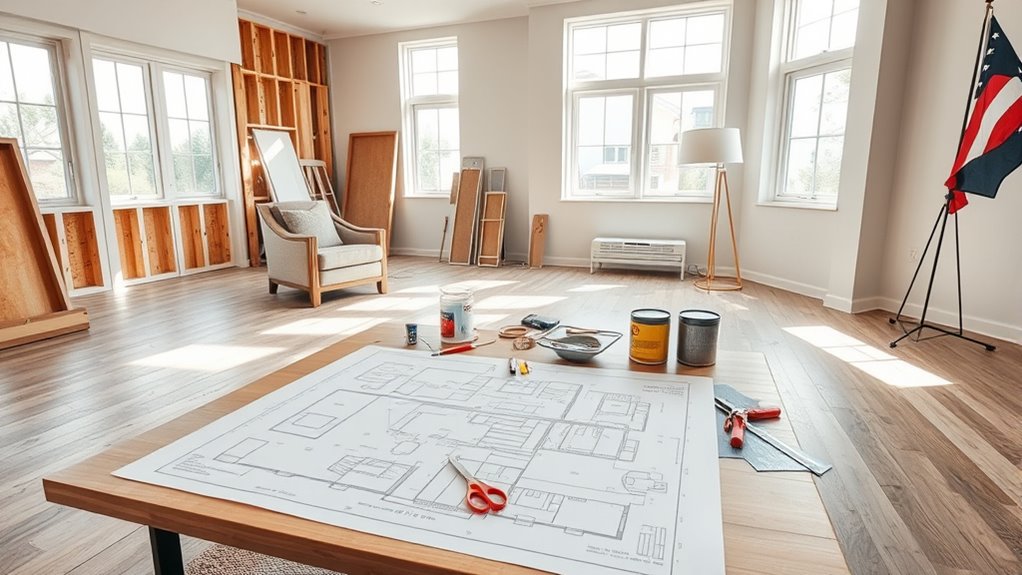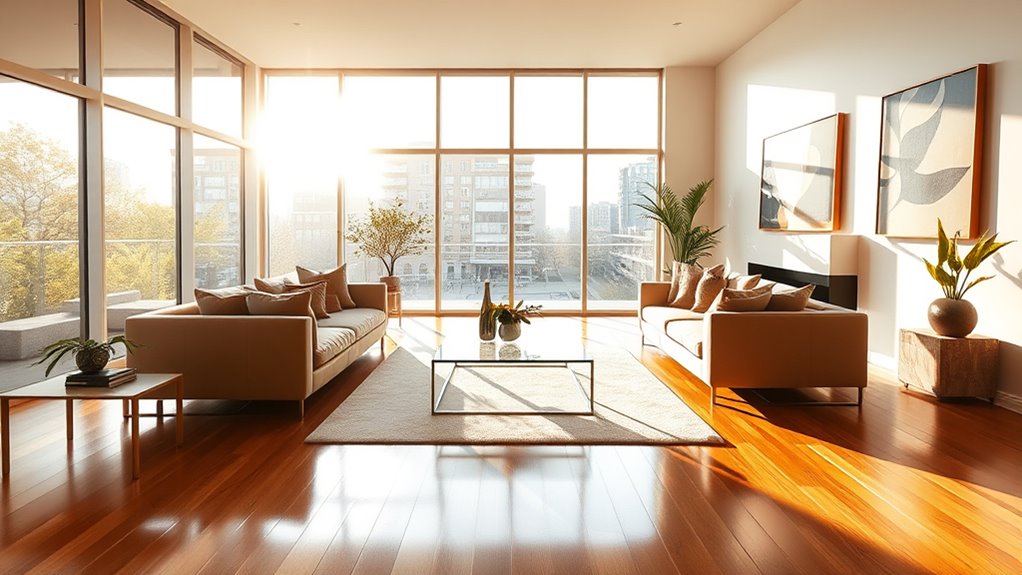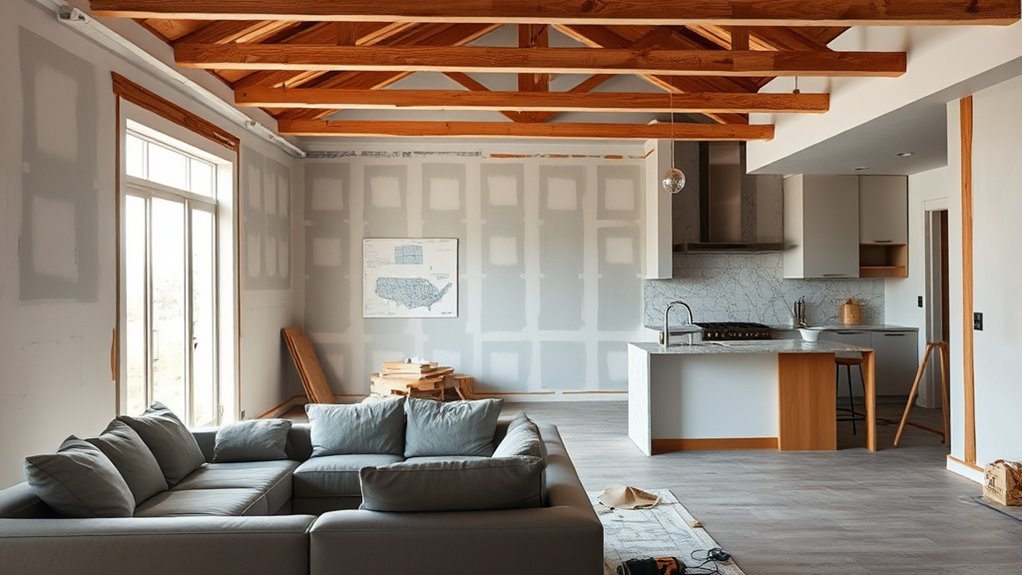Start by evaluating your immediate needs and which spaces impact your safety, comfort, or daily routines most. Focus on projects like updating the kitchen or bathroom first, as they improve functionality and ease your day-to-day life. Keep your budget in mind and choose cost-effective solutions. Planning a phased approach ensures smooth progress and minimizes disruption. Stay tuned to discover how long-term value and future flexibility can guide your choices for a successful remodel.
Key Takeaways
- Prioritize rooms with urgent safety or functionality issues, like kitchens or bathrooms, first.
- Focus on areas that will significantly improve daily routines and convenience.
- Consider your budget, choosing projects that maximize value without overspending initially.
- Start with spaces that enhance curb appeal or resale value for long-term benefits.
- Plan a phased approach, tackling key areas first and scheduling aesthetic updates later.
Assessing Your Immediate Needs and Priorities

Before diving into your home remodel, it’s essential to identify what needs attention most urgently. Start by evaluating your immediate needs and priorities. Consider how your space functions daily—does the kitchen need a facelift or the bathroom more storage? Think about your decorative preferences, including preferred color schemes, to ensure the renovation aligns with your style. Prioritize projects that improve safety, comfort, or functionality first. Clarify whether aesthetic updates, like new paint colors or decor, can wait or should be addressed immediately. By pinpointing what matters most—be it a structural fix or a design update—you set a clear direction for your project. Incorporating self-watering plant pots into your space can also enhance your indoor environment and reduce maintenance, making your home more comfortable and sustainable. This step ensures your remodel addresses your true needs and reflects your personal taste, making the process smoother and more satisfying.
Evaluating Budget and Resource Constraints

Once you’ve identified your priorities, it’s time to assess your budget and available resources. Start by determining how much you can realistically allocate to each project. Material selection plays a key role here—opting for cost-effective materials can stretch your budget without sacrificing quality. When considering contractor selection, get multiple estimates to compare costs and ensure you’re getting the best value. Keep in mind that unforeseen expenses can arise, so setting aside a contingency fund is wise. Be honest about what resources are available, including time and labor, to avoid overcommitting. Additionally, exploring home decor options that maximize style within your budget can help you make smarter choices. By thoroughly evaluating these constraints, you’ll create a clear financial framework that guides your project choices and helps prioritize rooms that fit within your means.
Considering Impact on Daily Living and Lifestyle

How will each remodel project affect your daily routines and overall lifestyle? When choosing which room to prioritize, consider how aesthetic choices and decorative accents influence your comfort. For example, updating the kitchen might streamline meal prep, while revamping the living room can enhance relaxation. To help visualize, here’s a quick comparison:
| Project Priority | Impact on Lifestyle |
|---|---|
| Kitchen remodel | Improves functionality, saves time |
| Bathroom upgrade | Increases convenience and comfort |
| Living room redesign | Boosts relaxation and socialization |
| Bedroom makeover | Enhances rest and privacy |
Focusing on projects that make daily tasks smoother guarantees your home supports your lifestyle seamlessly.
Analyzing Potential Value Addition and Resale Benefits

When choosing which home remodel projects to prioritize, it’s important to contemplate not only how they improve daily living but also how they can boost your property’s value. Consider landscape enhancement, which can appreciably increase curb appeal and attract potential buyers. A well-maintained yard or attractive outdoor space creates a positive first impression. Additionally, focusing on energy efficiency upgrades, such as new insulation or energy-efficient windows, can lower utility costs and appeal to environmentally conscious buyers. These improvements demonstrate a commitment to sustainability and can lead to higher resale value. Incorporating vertical storage solutions and other space-maximizing strategies can further increase the functionality and appeal of your home. By strategically selecting projects that enhance outdoor aesthetics and reduce ongoing expenses, you maximize your home’s marketability and future return on investment.
Planning for Long-Term Functionality and Future Use

Planning for long-term functionality and future use requires you to think beyond immediate needs and consider how your home will serve you in the years ahead. Focus on adaptable storage solutions that can evolve with your lifestyle, preventing clutter and maintaining organization. Incorporate aesthetic upgrades that are timeless, ensuring your space remains appealing over time. Think about flexible layouts that can accommodate changing family dynamics or new technologies. Use the table below to prioritize features:
| Priority | Feature | Purpose |
|---|---|---|
| 1 | Ample Storage Solutions | Maximize space and convenience |
| 2 | Durable Aesthetic Upgrades | Maintain style longevity |
| 3 | Flexible Room Layouts | Adapt to future needs |
This approach helps you create a home that’s functional today and resilient for tomorrow. Recognizing the artistic significance of design elements can inspire more meaningful and enduring choices in your remodel.
Creating a Phased Approach for a Smooth Remodel Process

To guarantee your home remodel proceeds smoothly, breaking the project into manageable phases is essential. Start by identifying key areas to focus on first, such as kitchens or bathrooms, where recent design trends can set the tone for the entire home. As you plan each phase, prioritize material selection to align with your overall style and budget. Incorporating current design trends early ensures cohesive flow between spaces, while staggered phases help manage costs and minimize disruption. Use a detailed timeline to coordinate demolition, construction, and finishing touches, allowing for adjustments along the way. A phased approach keeps the project organized, reduces overwhelm, and ensures each stage builds seamlessly toward your dream home, with attention to both style and practicality. Additionally, understanding home renovation priorities can help you effectively allocate resources and time to the most impactful areas first.
Frequently Asked Questions
How Do I Decide Which Room to Start Remodeling First?
When deciding which room to remodel first, consider your budget planning and timeline management. Focus on the space that offers the most value or needs urgent attention, like a kitchen or bathroom. Assess your budget to prevent overspending and set a realistic timeline to keep the project on track. Starting with a manageable project helps build momentum and ensures smoother progress for your entire home remodel.
Should I Prioritize Aesthetic Updates or Structural Repairs Initially?
You should prioritize structural repairs over aesthetic updates like decorative accents and color schemes. Fixing foundational issues guarantees your home’s safety and stability, making it easier to enjoy new paint or decor later. Once the essentials are addressed, you can confidently add decorative accents and choose color schemes that truly enhance your space. This approach saves you time and money, giving you a solid foundation for beautiful, lasting improvements.
How Can I Minimize Disruption During Major Renovation Projects?
To minimize disruption during major renovations, start with thorough budget planning and choose a reliable contractor early on. Clear communication helps set expectations and keeps the project on track. Protect your daily routines by establishing temporary spaces and covering work areas. Staying organized and proactive guarantees the renovation runs smoothly, reducing stress and inconvenience. With careful planning and the right team, you’ll experience fewer disruptions and enjoy your upgraded space sooner.
What Safety Considerations Should I Keep in Mind During Remodeling?
During your remodel, prioritize safety by addressing fire safety and electrical hazards. Keep fire extinguishers readily accessible and install smoke detectors if not already in place. Hire licensed electricians to handle wiring, ensuring all electrical work meets safety codes. Keep work areas tidy to prevent trips and falls, and use protective gear. Regularly inspect for hazards, and communicate safety protocols clearly to everyone involved, safeguarding your home and loved ones effectively.
How Do I Coordinate Multiple Contractors Across Different Rooms?
You’re juggling multiple contractors, like a conductor with an orchestra. To keep harmony, focus on contractor scheduling and clear project sequencing. Share a master timeline, so everyone knows their role and deadlines. Regular check-ins prevent overlaps and delays, ensuring each room’s work flows smoothly. By coordinating effectively, you turn chaos into a well-orchestrated project, saving time and stress while transforming your home seamlessly.
Conclusion
Remember, choosing which room to remodel first is like planting a seed—you want it to grow into something lasting and beautiful. By evaluating your needs, budget, and lifestyle, you set the foundation for success. Think of it as crafting your own personal legend, where each step builds toward your dream home. Start smart, plan carefully, and soon you’ll see your home transform into the sanctuary you’ve always envisioned—just like a hero’s journey, one step at a time.









